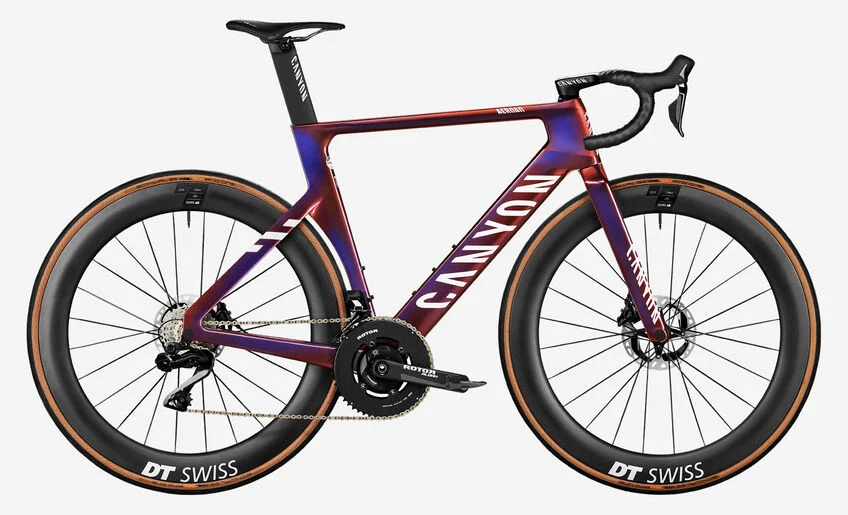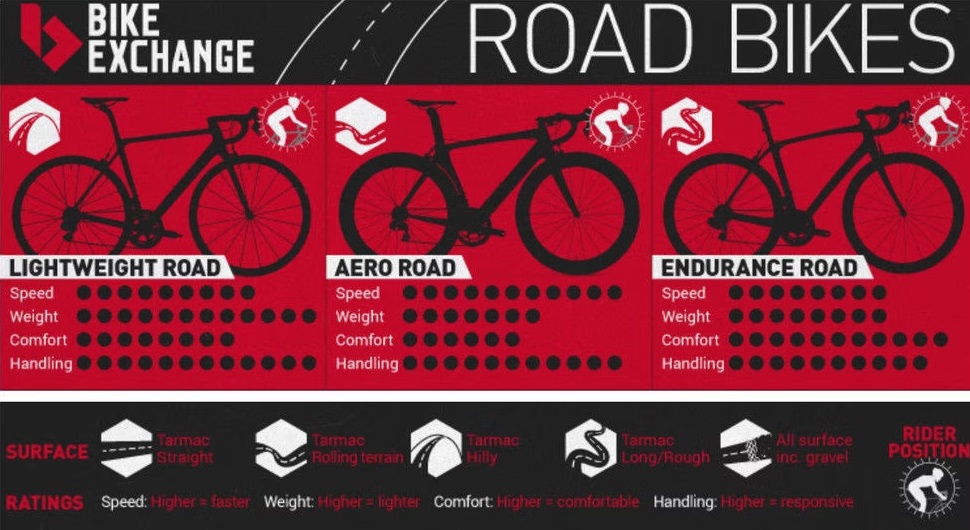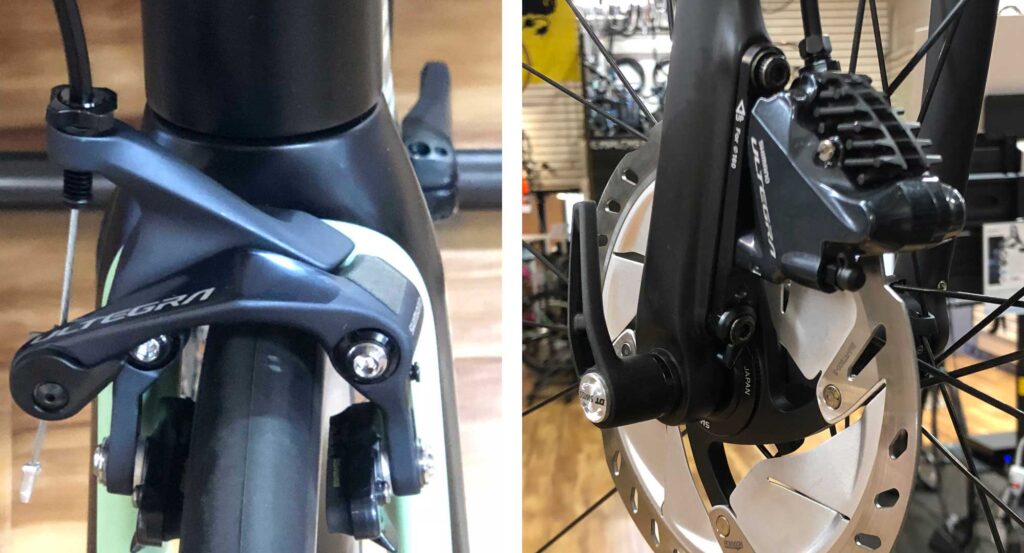Choosing your first road bike is an exciting journey, marking the beginning of a new adventure into the world of cycling. With modern advancements, carbon frames have become the standard for their excellent blend of strength, lightness, and durability, making them the preferred choice for most cyclists today. Let’s dive into the essential aspects you need to consider, focusing on the bike’s purpose, geometry, gearing and braking system options.
Understanding Bike Purpose and Geometry
Bike geometry, the blueprint of your bike’s dimensions, significantly influences how the bike handles and fits. A relaxed geometry is conducive to comfort and stability, ideal for beginners and endurance rides. Conversely, a more aggressive geometry enhances aerodynamics and speed, suited for racing enthusiasts or people who spend a lot of time at higher speeds.
– Aero Bikes:

Up to around 80% of our energy goes into the wind resistance, so every aero gain yields a huge performance benefit.
Aero bikes represent the pinnacle of engineering and design in the cycling world, meticulously crafted for those who prioritize speed and efficiency above all else. These bikes are not just vehicles but tools engineered to conquer air resistance, the most formidable adversary a cyclist faces on flat terrains. The philosophy behind aero bikes is simple yet profoundly impactful: to slice through the wind with the least amount of resistance possible. This objective drives the innovation and technological advancements seen in their design and manufacturing.
The aggressive geometry of an aero bike is one of its most distinguishing features. Unlike traditional road bikes, which may offer a more relaxed posture, aero bikes are designed with a forward-leaning stance in mind. This positioning is crucial for reducing the cyclist’s frontal area exposed to the wind, thereby minimizing drag. It’s a design choice that serves a dual purpose: it not only makes the bike faster but also instills a sense of direct, aggressive control over the bike, suitable for high-speed racing and dynamic riding on flat terrains.
Aerodynamic shaping further complements this geometry. Every curve and contour of an aero bike is there for a reason, sculpted based on wind tunnel testing and computational fluid dynamics (CFD) analysis. The frames are often sleek, with tubes designed to cut through the air efficiently. Manufacturers might integrate components such as brakes and cables into the frame itself to maintain a smooth surface that disrupts airflow as little as possible. This attention to detail ensures that aero bikes offer unparalleled performance in conditions where air resistance plays a significant role.
The significance of reducing wind resistance cannot be overstated. On flat terrains, where elevation changes are minimal, the primary challenge a cyclist faces is not gravity but the air itself. It is estimated that up to around 80% of a rider’s energy expenditure goes into overcoming air resistance. Hence, any improvement in aerodynamics can lead to significant gains in speed and efficiency. This is why aero bikes, with their focus on cutting through the wind, offer a substantial advantage in such scenarios. The reduction in drag means that cyclists can maintain higher speeds for the same amount of effort, a critical factor in racing and fast-paced riding.
To further aid in their quest for speed, aero bikes are typically equipped with deep-section carbon wheels. These wheels, ranging from 50 to 80 mm in depth, are not just about aesthetics; they play a crucial role in enhancing the bike’s aerodynamic profile. The depth of the wheels helps to smooth the airflow around the bike and reduce turbulence, which, in turn, cuts down on drag. This integration of deep wheels with the aero frame creates a synergistic effect, making the bike even more efficient at high speeds.
However, the benefits of aero bikes are not without their trade-offs. The very features that make them fast on flat terrains can also lead to a harsher ride quality, as the stiff frames and deep wheels are less effective at absorbing road vibrations. Additionally, the aggressive riding position may not be comfortable for everyone, especially over long distances. These are considerations that riders must weigh against the performance benefits offered by aero bikes.
In conclusion, aero bikes are marvels of modern cycling technology, designed with a singular focus on speed and efficiency. Their aggressive geometry, aerodynamic shaping, and deep-section wheels make them the ideal choice for racers and enthusiasts looking to dominate flat terrains. By minimizing air resistance, these bikes unlock performance gains that can be the difference between standing on the podium and being part of the peloton. As cycling continues to evolve, the aero bike stands as a testament to the relentless pursuit of speed, a beacon for those who seek to push the limits of what is possible on two wheels.
– Climbing Bikes:

When the call of the mountains beckons, a climbing bike stands out as the optimal choice for tackling those daunting ascents with ease. Characterized by their feather-light frames and agile handling, these bikes are engineered to conquer steep gradients without compromising on performance. The secret to their prowess lies in a meticulously designed geometry, which optimizes your positioning on the bike, ensuring maximum efficiency and comfort during climbs.
Key Features of Climbing Bikes:
- Optimized Geometry:
- Climbing bikes are designed with a specific geometry that positions the rider in an optimal stance for uphill efforts. This often means a slightly more upright position to enhance breathing and power output, coupled with a shorter wheelbase for responsive handling on tight switchbacks and steep slopes.
- Lightweight Construction:
- Every gram matters when you’re ascending. Climbing bikes prioritize weight reduction, employing advanced materials like carbon fiber to construct frames that are both sturdy and feather-light. This reduction in weight translates directly into improved performance, allowing you to maintain higher speeds with less effort.
- Wheelset Considerations:
- The wheels on climbing bikes are engineered for maximum efficiency on ascents. Typically, these bikes are equipped with shallow-rimmed wheels, around 25 mm deep, to minimize rotational mass and aerodynamic drag, which becomes increasingly beneficial as the gradient kicks up.
- Structural Rigidity:
- A paramount feature of climbing bikes is the rigidity of their frames and components. This stiffness ensures that every ounce of effort you put into pedaling is effectively converted into forward motion. It’s this direct power transfer that can make the difference between surging ahead or falling back on a challenging climb.
- Weight-to-Power Ratio:
- In the world of climbing, the power-to-weight ratio reigns supreme. A lighter bike means you’re hauling less weight uphill, which can significantly enhance your watts-per-kilogram output. This efficiency is crucial for climbing performance, as it allows you to sustain higher speeds with the same power output, making climbs not only faster but also more manageable.
- Componentry:
- Climbing bikes are often equipped with components that further reduce weight and enhance performance. From ultralight carbon handlebars to minimalist saddles and lightweight drivetrains, every part is chosen with the ascent in mind. Gearing is also a critical consideration, with many climbing bikes featuring compact cranksets and wide-range cassettes to provide the optimal gear ratios for steep pitches.
- Aerodynamics:
- While aerodynamics might be more closely associated with flat, fast riding, recent advancements have seen climbing bikes incorporate aero features without significant weight penalties. This includes aerodynamically shaped tubes and integrated components, ensuring that even when the road tilts upwards, you’re cutting through the air with minimal resistance.
– Endurance Bikes:

For those who hear the call of the open road and the allure of the long haul, endurance bikes stand as the quintessential choice. Tailored for the long-distance aficionado, these bikes are a testament to comfort and resilience, designed to carry you across vast distances with ease. Their defining characteristic is a geometry that promotes a more upright riding posture, a boon for reducing strain on the back, neck, and shoulders, thereby mitigating rider fatigue over countless miles.
The Essence of Endurance Bikes:
- Comfort-Centric Geometry:
- The cornerstone of an endurance bike’s design is its geometry, which is fine-tuned for stability and comfort. A slightly taller head tube, coupled with a longer wheelbase, positions the rider in a more upright stance. This not only enhances visibility and control but significantly reduces the strain on the rider’s body, making long stints in the saddle more manageable and enjoyable.
- Vibration Damping:
- Road vibrations and shock absorption are critical concerns for endurance riders. To address this, endurance bikes often incorporate specific design features and materials, such as carbon fiber composites with natural vibration-damping properties, or engineered flex zones in the frame and fork. Some models also include additional damping technologies, like specialized seat posts or integrated handlebar systems, to further smooth out the ride.
- Wider Tires for Comfort and Grip:
- Endurance bikes are typically equipped with wider tires, ranging from 28mm to 32mm or even broader, depending on the bike’s design and intended use. These wider tires can be run at lower pressures, offering a plush ride that absorbs bumps and provides improved traction—a critical factor for maintaining control and comfort on variable surfaces.
- Versatility and Adaptability:
- These bikes are designed with versatility in mind, often featuring clearance for even wider tires and mounts for accessories like mudguards and racks. This adaptability makes endurance bikes suited not only for long road rides but also for light gravel and adventure riding, ensuring you’re well-equipped for wherever your journey takes you.
- Gearing for the Long Haul:
- Understanding the demands of prolonged climbs and diverse terrain, endurance bikes are outfitted with gearing that supports a broad range of riding conditions. Compact cranksets paired with wide-range cassettes ensure that you have both the high gears for speedy flats and the low gears for grinding up extended ascents without overtaxing your legs.
- Focus on Performance:
- While comfort is paramount, performance is not sidelined. Modern endurance bikes strike a balance, incorporating elements of aerodynamic efficiency and lightweight construction without compromising the ride’s plushness. This ensures that even as you benefit from the comfort-oriented design, you’re not left wanting for speed or responsiveness.
Bike Types comparison
The picture below illustrates the level of each factor that is associated with each type of bike that we ride and as you can notice there is no perfect bike that does everything great, but it’s obvious that it’s all about the priorities.

Selecting your first road bike is about finding the right balance between comfort, performance, and budget. Consider the type of riding you’ll be doing most and prioritize the features that will enhance your cycling experience. Whether it’s the aerodynamic efficiency of an aero bike, the lightweight agility of a climbing bike, the comfort of an endurance bike, the reliable gearing of the big brands, or the braking system that best suits your needs, the perfect bike is out there waiting for you. For a deeper dive into the nuances of each component and more tailored advice, visiting your local bike shop or consulting with seasoned cyclists can provide invaluable insights.
Let’s chose the components of the bike, is it simple?
When it comes to gearing, two giants dominate the market: Shimano and SRAM. Each offers a range of products tailored to different performance and durability levels, and of course budgets.
- Shimano: Known for its reliability and smooth shifting, Shimano’s popular road bike groupsets include:
- 105: A favorite among entry-level and intermediate riders, offering a balance between performance and cost. The basic level with really low cost, but it does a pretty good job, durable and still manages to provide a good level of performance. The downside usually is the additional weight that accumulates into overall bike’s weight.
- Ultegra: A step up from the 105, Ultegra provides enhanced performance with lighter materials and more refined technology, suitable for more serious enthusiasts. The Ultegra level provides even better performance while saving more precious weight at a cost of extra $$.
- Dura-Ace: The pinnacle of Shimano’s offerings, Dura-Ace is the choice of professionals and high-performance riders, boasting the best in weight, efficiency, and precision. The downside sometimes can be the durability, because the Dura Ace was invented with the ultimate goal of weight saving while managing enough strength to endure. For example – the rear cassette of Dura Ace model has the biggest gears made of magnesium which yields a very light weight, but the durability is low while cost is very high.
- SRAM: Praised for its innovative designs and functionality, SRAM’s lineup also caters to a broad audience:
- Their equivalents to Shimano’s range offer similar tiers from entry-level to professional-grade components, with variations in weight, material, and technology. SRAM’s levels come with similar approach of making a levels that differ with weight, performance, durability and cost
Braking Systems: V-Brakes vs. Disc Brakes

The debate between V-brakes and disc brakes is ongoing, with each system having its own set of advantages and practical uses.
- V-Brakes: Traditionally found on road bikes, V-brakes offer simplicity and ease of maintenance. They are lighter than disc brakes and provide sufficient stopping power for most road riding conditions. However, their performance can be affected by wet and muddy conditions, including some limiting factors like if a rider is heavyweight and goes a steep descent with corners – that might be a scary experience because the brakes have their limits. The advantages are: lightweight, easy to mount/dismount wheels, no squeaky noise when brakes are not applied.
- Disc Brakes: Gaining popularity for their consistent performance in various conditions, disc brakes offer superior stopping power and control, especially in wet and challenging weather. While they add a bit of weight and complexity to the bike, disc brakes offer superior braking performance, but they are more expensive and heavier than V-brakes. V-brakes are less expensive and lighter, but they offer less braking power than disc brakes. The best type of brake for you will depend on your individual needs and preferences. Their advantages in safety and performance make them a favored choice for many modern road bikes. Disc brakes come with ventilated rotors at the higher level of components (Ultegra level and above) and provide a constant feeling that they will give performance at any time they are applied.
what type of activities and usage you are going to do?

To make the good choices with choosing bike and components – ask yourself these questions:
- What type of your typical riding terrains.
- What type of conditions.
- What are your priorities among the factors of speed, weight, reliability, budget, etc.
As many tests have shown – the advantages of aero bikes are significantly higher on almost any ride because every moment that you spend at speeds higher than around 20 kph – the aero has a huge impact on the speed as the air resistance grows squared from the speed.
If you’re aiming for lightweight ride in fair weather, a bike with V-brakes might be an option as a cheap entrance to this hobby. However, for all-weather riders who prioritize control and safety, disc brakes could be the better option.
Remember, the best bike is not always the most expensive one but the one that best meets your specific cycling needs and aspirations. Happy riding!
By Sam Sanders




